warning ASTON MARTIN DB7 1997 Repair Manual
[x] Cancel search | Manufacturer: ASTON MARTIN, Model Year: 1997, Model line: DB7, Model: ASTON MARTIN DB7 1997Pages: 421, PDF Size: 9.31 MB
Page 223 of 421

D=27
Electrics
Seat Belt Pretensioner
050C Pretensioner Squib High Resistance 050D Pretensioner squib low resistance
050C will be logged if the resistance of the
pretensioner squib circuit rises above 4.5 ±0.5C2
050D will be logged if the resistance of the
pretensioner squib circuit falls below 1.4 ±0.4Q
Procedure
Read the warnings given at the start of this
pretensioner diagnostics section.
Connect the PDU to the lower diagnostic socket
and access the pretensioner control module. Verify
that an 050C code is logged and note if the fault is
shown as internnittent. Note any other codes in the
DTC log and then clear ail codes.
Switch off the ignition and wait at least 10 minutes
for the pretensioner squib firing capacitors to fully
discharge before continuing with this procedure.
Disconnect the pretensioner squib connector at the
rearward harness. Disconnect the pretensioner
control module and temporarily cheat the squib
shorting link.
3.
Procedure
Read the warnings given at the start of this
pretensioner diagnostics section.
Connect the PDU to the lower diagnostic socket
and accessthe pretensioner control module. Verify
that an 050D code is logged and note if the fault is
shown as intermittent. Note any other codes in the
DTC log and then clear all codes.
Switch off the ignition and wait at least 10 minutes
for the pretensioner squib firing capacitors to fully
discharge before continuing with this procedure.
Disconnect the pretensioner squib connector atthe
rearward harness. Disconnect the pretensioner
control module and temporarily cheat the squib
shorting link.
Note: The control module harness connector has a
shorting link which
short
circuits the squib
lines together
when the connector is displaced. Carefully insert a
suitable non-metallic
cheater to
remove
the short
circuit
between pins 11 and 12 before continuing with fault
diagnosis.
.j^ 'o o ob bo oooooooo
O O O
iV ^3 ^3 ^3 ^3 ^3 ^
lU Insert cheater here
Check the continuity of the squib feed and return
lines.
If any significant resistance is measured,
service the wiring as necessary.
Also check the condition of the connector pins for
damage or lack of tension and service
as
necessary.
If the circuit resistance is acceptable and the
connector pins are good, go to step 6.
If any defects are identified and serviced, go to step
7.
If the checks in step 4 are good, the high circuit
resistance must be in the pretensioner squib or in
thecontrol module. Replace the pretensioner squib
and reconnect all components.
Clearall logged DTCs from the pretensioner control
module and then test the vehicle.
If the 050C code is logged again, replace the
control module.
Note: The control module harness connector has a
shorting link which
short
circuits the squib
lines together
when the connector is displaced. Carefully insert a
suitable non-metallic
cheater to remove the
short circuit
between pins 11 and 12 before continuing with fault
diagnosis.
Insert cheater here
Check the continuity from the squib feed line to the
squib return line. With the shorting link cheated,
the resistance should be more than lOkQ. If the
resistance is less than 10kQ, service the wiring as
necessary.
Also check the connector pins for any damage
which could cause an unintentional short circuit.
If the checks in step 5 are good, the low circuit
resistance must be in the pretensioner squib or in
thecontrol module. Replace the pretensioner squib
and reconnect all components.
Clearall logged DTCs from the pretensioner control
module and then test the vehicle.
If the 050D code is logged again, replace the
control module.
September 1996 6-107
Page 224 of 421
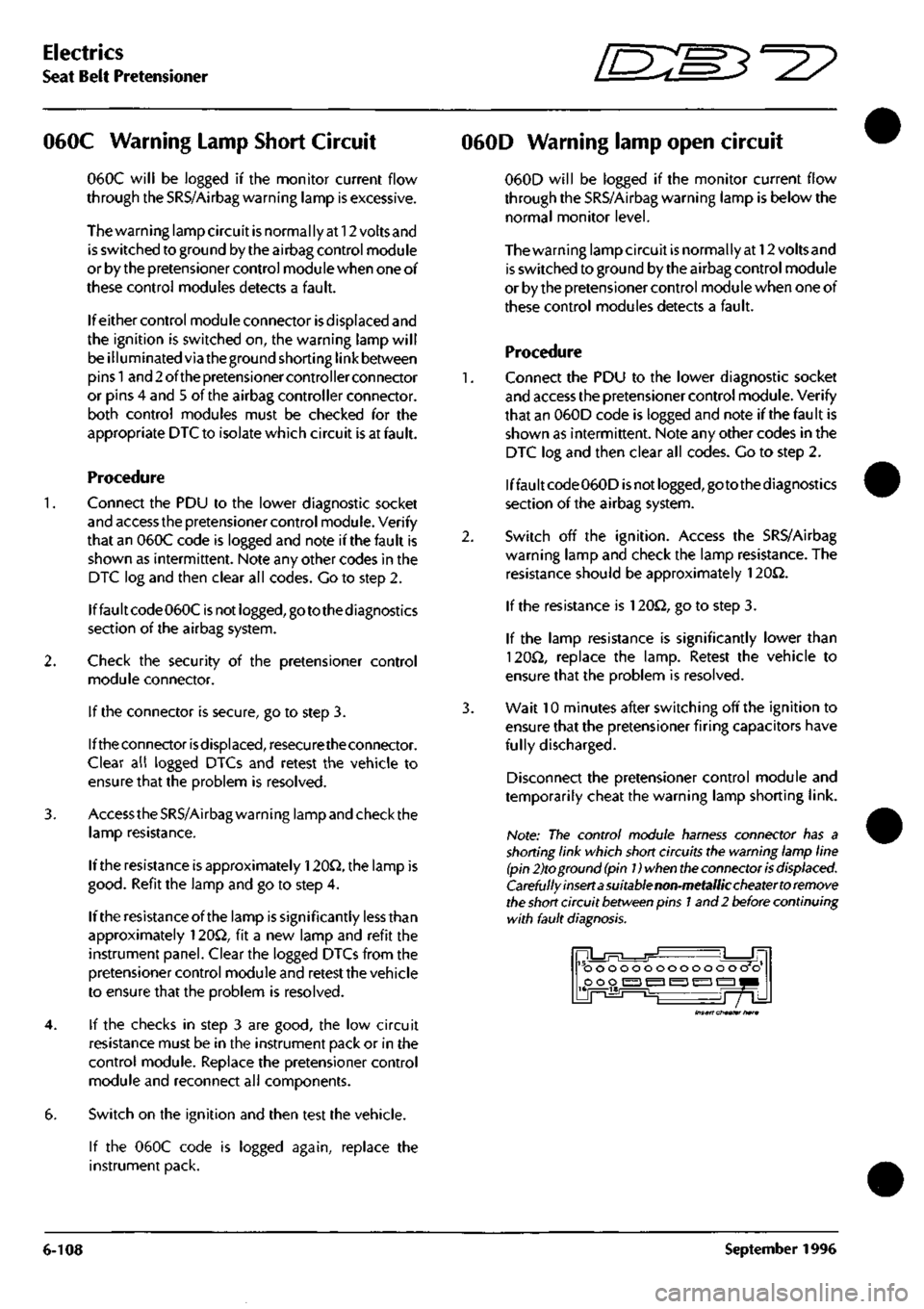
Electrics
Seat Belt Pretensioner ^?
060C Warning Lamp Short Circuit
060C will be logged if the nnonitor current flow
through the SRS/Airbag warning lamp is excessive.
The warning lamp circuit is normally at 12 volts and
is switched to ground by the airbag control module
or by the pretensioner control module when one of
these control modules detects a fault.
If either control module connector is displaced and
the ignition is switched on, the warning lamp will
be illuminated via the ground shorting link between
pins!
and 2 ofthe pretensioner controller connector
or pins 4 and 5 of the airbag controller connector,
both control modules must be checked for the
appropriate DTC to isolate which circuit is at fault.
Procedure
1.
Connect the PDU to the lower diagnostic socket
and access the pretensioner control module. Verify
that an 060C code is logged and note if the fault is
shown as intermittent. Note any other codes in the
DTC log and then clear all codes. Go to step 2.
If fault code 060C is not logged, go to the diagnostics
section of the airbag system.
2.
Check the security of the pretensioner control
module connector.
If the connector is secure, go to step 3.
If the connector isdisplaced,resecu re theconnector.
Clear all logged DTCs and retest the vehicle to
ensure that the problem is resolved.
3. Access the SRS/Airbag warning lamp and check the
lamp resistance.
If the resistance is approximately
120£2,
the lamp is
good.
Refit the lamp and go to step 4.
If the resistance of the lamp is significantly less than
approximately 120^, fit a new lamp and refit the
instrument panel. Clear the logged DTCs from the
pretensioner control module and retest the vehicle
to ensure that the problem is resolved.
4.
If the checks in step 3 are good, the low circuit
resistance must be in the instrument pack or in the
control module. Replace the pretensioner control
module and reconnect all components.
6. Switch on the ignition and then test the vehicle.
If the 060C code is logged again, replace the
instrument pack.
060D Warning lamp open circuit
060D will be logged if the monitor current flow
through the SRS/Airbag warning lamp is below the
normal monitor level.
The warning lampcircuit is normally at 12 voltsand
is switched to ground by the airbag control module
or by the pretensioner control module when one of
these control modules detects a fault.
Procedure
Connect the PDU to the lower diagnostic socket
and access the pretensioner control module. Verify
that an 060D code is logged and note if the fault is
shown as intermittent. Note any other codes in the
DTC log and then clear all codes. Go to step 2.
lffaultcode060D is not
logged,
gotothediagnostics
section of the airbag system.
Switch off the ignition. Access the SRS/Airbag
warning lamp and check the lamp resistance. The
resistance should be approximately 120Q.
If the resistance is 120i2, go to step 3.
If the lamp resistance is significantly lower than
120^2,
replace the lamp. Retest the vehicle to
ensure that the problem is resolved.
Wait 10 minutes after switching off the ignition to
ensure that the pretensioner firing capacitors have
fully discharged.
Disconnect the pretensioner control module and
temporarily cheat the warning lamp shorting link.
Note: The control module harness connector has a
shorting link which short circuits the warning lamp line
(pin 2)to ground
(pin
Dwhen
the
connector
is
displaced.
Carefully insert a suitable non-metallic cheater to remove
the
short
circuit
between
pins
1
and 2 before continuing
with fault
diagnosis.
ooooooooooooo o o poo
i^i
^ ^ ^ 1^1
Insert cheater hare
6-108
September
1996
Page 225 of 421

Electrics
Seat Belt Pretensioner
Check the continuity of
the
line from pretensioner
control module pin 2 to instrument pack green
connector pin 2.
If continuity is approximately
OQ,
go to step 5.
If the line resistance
is
significantly greater
than
OQ,
service the wiring as necessary. Reconnect all
components and test the vehicle to ensure that the
problem is resolved.
Ifthe lamp
and
wiring
checks are
good,
the
fault lies
in the instrument pack or in the control module.
Replace the control module and retest. Ifthe fault
persists, replace the instrument
pack.
Reconnectall
components and test the vehicle to ensure that the
problem is resolved.
Pretensioner Control Module Internal
Faults
The following codes indicate internal faults within the
pretensioner control module.
0209 Safing sensor error
030A Temperature sensor error
0D13 Capacitor voltage error
0D14 Capacitor capacitance
0D09 Energy reserve switch
0D1E Energy shutdown switch
050E Seatbelt pretensioner switch error
0109 Accelerometer function
01OA Acceleration out of range
01 OB
Acceierometer offset
OAOC Analogue voltage error
090A EEPROM not programmed
0909 EEPROM checksum
090C RAM check error
060E Warning lamp driver error
0A09 Communications error
OAOA External watchdog error
OAOB External watchdog time out
020A Safing sensor not closed
If any of the above codes are logged, replace the
pretensioner control module.
September 1996 6-109
Page 227 of 421
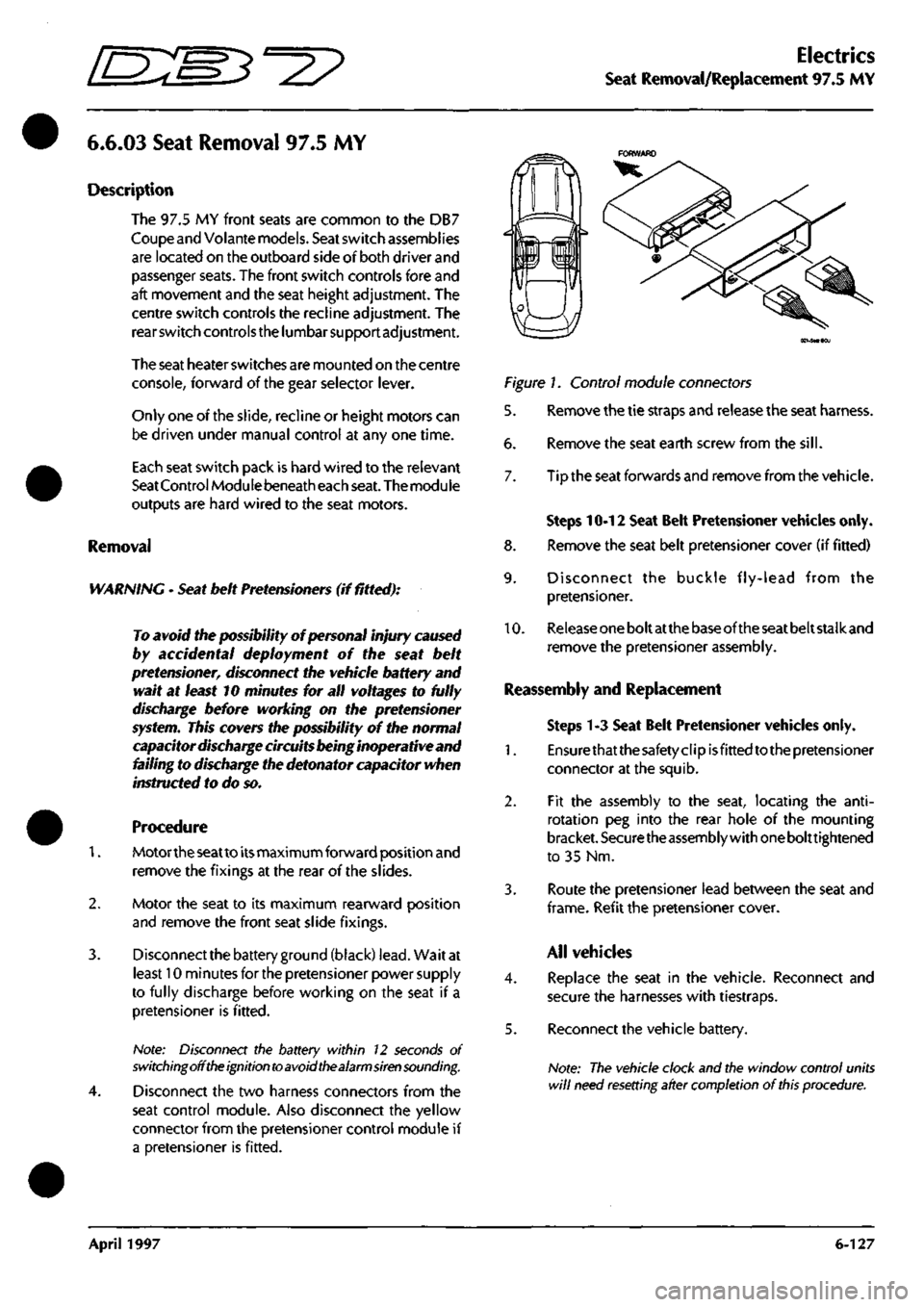
3-^?
Electrics
Seat Removal/Replacement 97.5 MY
6.6.03
Seat Removal 97.5 MY
Description
The 97.5 MY front seats are common to the DB7
Coupe
and
Volante
models.
Seat
switch
assembi ies
are located on the outboard side of both driver and
passenger
seats.
The front switch controls fore and
aft movement and the seat height adjustment. The
centre switch controls the recline adjustment. The
rear switch
controls
the
lumbar support adjustment.
The seat
heater switches are mounted on the centre
console, forward of the gear selector
lever.
Only one of
the
slide,
recline or height motors can
be driven under manual control at any one time.
Each seat switch pack is hard wired to the relevant
Seat Control
Module
beneath each
seat.
The
module
outputs are hard wired to the seat motors.
Removal
WARNING -
Seat
belt
Pretensioners
(if fitted):
To avoid the possibility
of
personal
injury
caused
by accidental deployment of the seat belt
pretensioner,
disconnect
the
vehicle battery and
wait at
least
10
minutes
for all
voltages
to fully
discharge
before working on the
pretensioner
system.
This covers the possibility
of
the normal
capacitor
discharge
circuits being inoperative and
failing to discharge the detonator capacitor when
instructed
to
do
so.
Procedure
1.
Motortheseatto
its
maximum forward position and
remove the fixings at the rear of the slides.
2.
Motor the seat to its maximum rearward position
and remove the front seat slide fixings.
3. Disconnect the battery
ground
(black)
lead.
Wait at
least 10 minutes for the pretensioner power supply
to fully discharge before working on the seat if a
pretensioner is fitted.
Note: Disconnect the battery within 12 seconds of
switching off the ignition to avoid the alarm siren sounding.
4.
Disconnect the two harness connectors from the
seat control module. Also disconnect the yellow
connector from the pretensioner control module if
a pretensioner is fitted.
Figure 1. Control module connectors
5. Remove the tie straps and release the seat harness.
6. Remove the seat earth screw from the
sill.
7. Tip the seat forwards and remove from the vehicle.
Steps 10-12 Seat Belt Pretensioner vehicles only.
8. Remove the seat belt pretensioner cover (if fitted)
9. Disconnect the buckle fly-lead from the
pretensioner.
10.
Release
one
bolt at
the
base of the
seat
belt stalk and
remove the pretensioner assembly.
Reassembly and Replacement
Steps 1-3 Seat Belt Pretensioner vehicles only.
1.
Ensurethatthesafetyclipisfittedtothepretensioner
connector at the squib.
2.
Fit the assembly to the seat, locating the
anti-
rotation peg into the rear hole of the mounting
bracket.
Securethe
assembly with
one
bolttightened
to 35 Nm.
3. Route the pretensioner lead between the seat and
frame.
Refit the pretensioner
cover.
All vehicles
4.
Replace the seat in the vehicle. Reconnect and
secure the harnesses with tiestraps.
5. Reconnect the vehicle battery.
Note:
The vehicle clock and the window control units
will
need resetting after completion
of
this
procedure.
April 1997 6-127
Page 228 of 421

Electrics
Seat Control Module Removal/Replacement 97.5 MY 'O "3^2?
Switch on the ignition and checi< that the airbag
warning lamp comes on when the ignition is
switched on and extinguishes after approximately
six seconds indicating satisfactory completion of
the pretensioner and airbag system self
tests.
Fit
the front
seat
retaining screws ensuring
a
1.2mm
gap between the screw heads
and
the
slides.
Power
the seat forward and refit the rear screws.
Caution:
Centralise the
rear
fixing holes
with the
body weld
nuts
prior to
inserting the
bolts.
Torque the rear screws to 25 Nm. Power the seat
backwards. Torque the front screws to 25 Nm.
Motor the seat through its full range of movement
to ensure correct
operation.
6.6.08
Seat Control Module 97.5 MY
Removal
WARNING -
Seat
belt
Pretensioners
(if
fitted):
To avoid the possibility
of
personal injury caused
by accidental deployment of the seat belt
pretensioner,
disconnect
the
vehicle battery and
wait at
least
10
minutes
for all
voltages
to fully
discharge
before
working
near the
pretensioner
system.
This covers
the
possibility
of
the
normal
capacitor
discharge circuits
being
inoperative and
failing to discharge the detonator capacitor when
instructed
to
do
so.
1.
Lower the door window and open the relevant
door. Disconnect
the
battery ground cableand wait
for 10 minutes if
a
pretensioner
is
fitted.
Otherwise,
proceed immediately to step 2.
(ei-SMiECu
Figure!.
Seat ECU Removal
2. Loosen two nuts securing the seat ECU. Slide the
ECU to the left and remove it from the front of the
seat.
3. Disconnect two connectors from the ECU.
Replacement
1.
Reconnect the two control module connectors. Fit
the seat control
moduleand
tighten
thetwo securing
nuts.
3. Reconnect the battery ground and test for correct
operation of the seat controls.
6-128 April 1997
Page 230 of 421
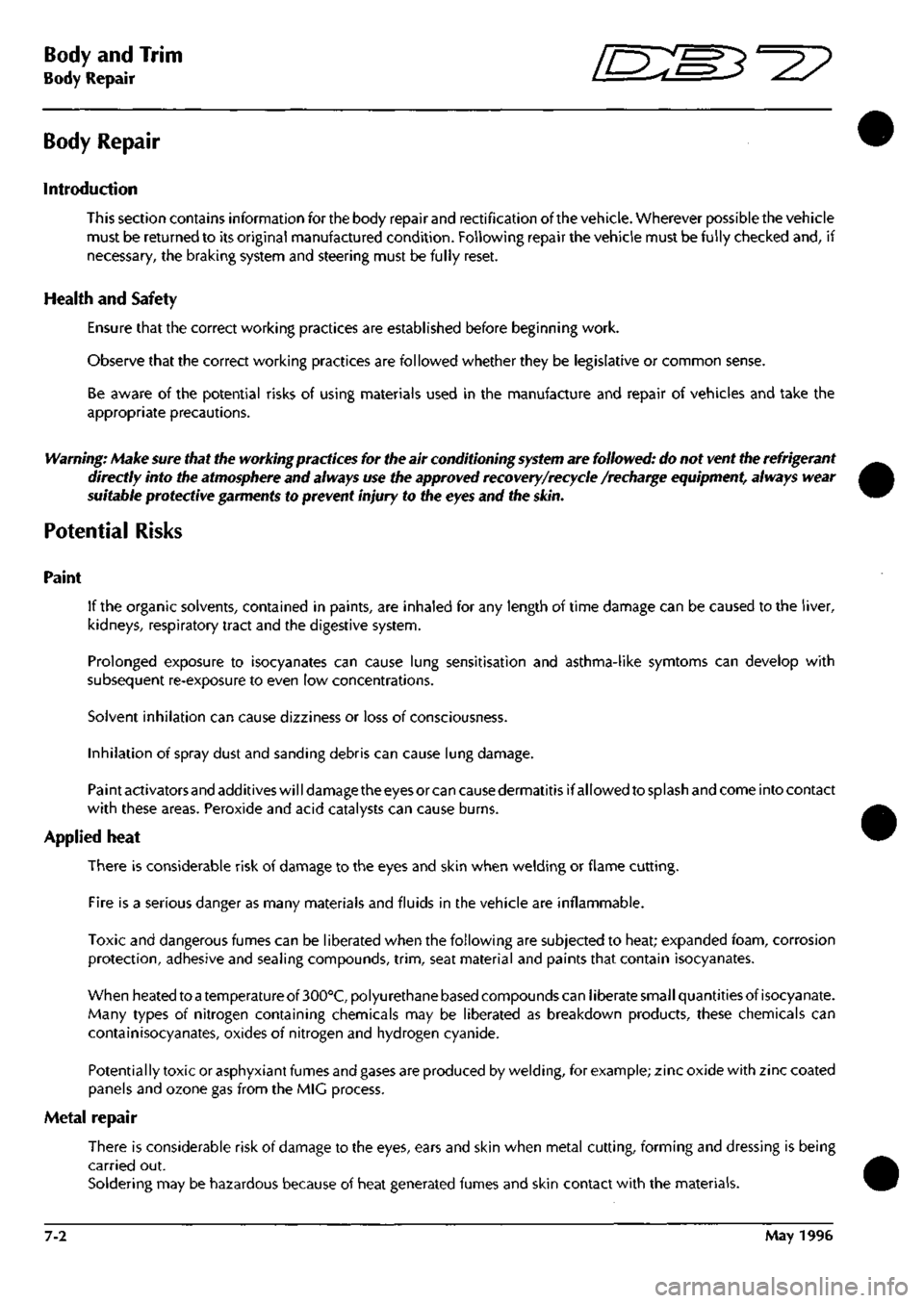
Body and Trim //-->> ^izz^^ ' ^ ^
Body Repair ' —^^ '-^ >^-/
Body Repair
Introduction
This section contains information for the body repair and rectification of the vehicle. Wherever possible the vehicle
must be returned to its original manufactured condition. Following repair the vehicle must be fully checked and, if
necessary, the braking system and steering must be fully reset.
Health and Safety
Ensure that the correct working practices are established before beginning work.
Observe that the correct working practices are followed whether they be legislative or common sense.
Be aware of the potential risks of using materials used in the manufacture and repair of vehicles and take the
appropriate precautions.
Warning: Make sure that the working practices for the air conditioning
system
are followed: do not vent the refrigerant
directly into the atmosphere and always use the approved recovery/recycle /recharge equipment, always wear
suitable protective garments to prevent injury to the eyes and the skin.
Potential Risks
Paint
If the organic solvents, contained in paints, are inhaled for any length of time damage can be caused to the liver,
kidneys, respiratory tract and the digestive system.
Prolonged exposure to isocyanates can cause lung sensitisation and asthma-like symtoms can develop with
subsequent re-exposure to even low concentrations.
Solvent inhilation can cause dizziness or loss of consciousness.
Inhilation of spray dust and sanding debris can cause lung damage.
Paint activatorsand additives will damage the eyesor can cause dermatitis if allowed to splash and come into contact
with these areas. Peroxide and acid catalysts can cause burns.
Applied heat
There is considerable risk of damage to the eyes and skin when welding or flame cutting.
Fire is a serious danger as many materials and fluids in the vehicle are inflammable.
Toxic and dangerous fumes can be liberated when the following are subjected to heat; expanded foam, corrosion
protection,
adhesive and sealing compounds,
trim,
seat material and paints that contain isocyanates.
When heated to
a
temperature of 300°C, polyu rethane based compounds can
1
iberate small quantities of isocyanate.
Many types of nitrogen containing chemicals may be liberated as breakdown products, these chemicals can
contain isocyanates, oxides of nitrogen and hydrogen cyanide.
Potentially toxic or asphyxiant fumes and gases are produced by welding, for example; zinc oxide with zinc coated
panels and ozone gas from the MIC process.
Metal repair
There is considerable risk of damage to the eyes, ears and skin when metal cutting, forming and dressing is being
carried out.
Soldering may be hazardous because of heat generated fumes and skin contact with the materials.
7-2 May 1996
Page 291 of 421
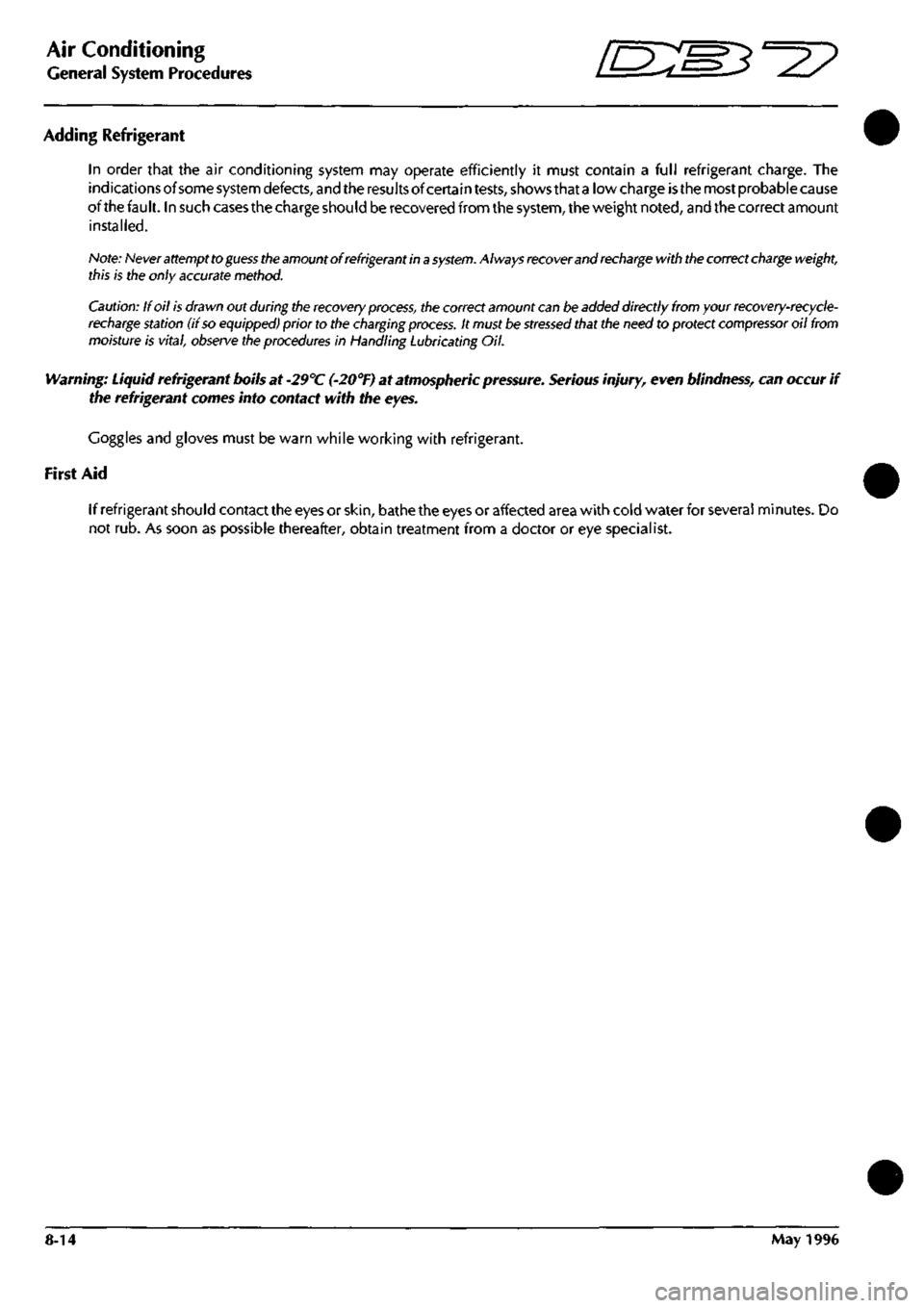
Air Conditioning //—->> "^^Izz^^ • ^ ^
General System Procedures L ^—/ ' —^ ^./^
Adding Refrigerant
In order that the air conditioning system may operate efficiently it must contain a full refrigerant charge. The
indications of some system defects, and the results of certain tests, shows that
a
low charge
is
the most probable cause
of the fault. In such cases the charge shou
Id
be recovered from the
system,
the weight noted, and the correct amount
installed.
Note: Never attempt to
guess the
amount of refrigerant in
a
system.
Always recover and
recharge
with
the
correct
charge
weight,
this is the only
accurate
method.
Caution: If oil is drawn out during the recovery
process,
the correct amount can be added directly from your
recovery-recycle-
recharge station
(if so
equipped)
prior to the charging
process.
It must be
stressed
that the need to protect
compressor
oil from
moisture is vital, observe
the procedures
in Handling Lubricating Oil.
Warning: Liquid refrigerant boils at -29°C (-20°F) at atmospheric pressure. Serious injury, even blindness, can occur if
the refrigerant comes into contact with the eyes.
Goggles and gloves must be warn while working with refrigerant.
First Aid
If refrigerant should contact the eyes or
skin,
bathe the eyes or affected area with cold water for several minutes. Do
not rub. As soon as possible thereafter, obtain treatment from a doctor or eye specialist.
8-14 May 1996
Page 311 of 421
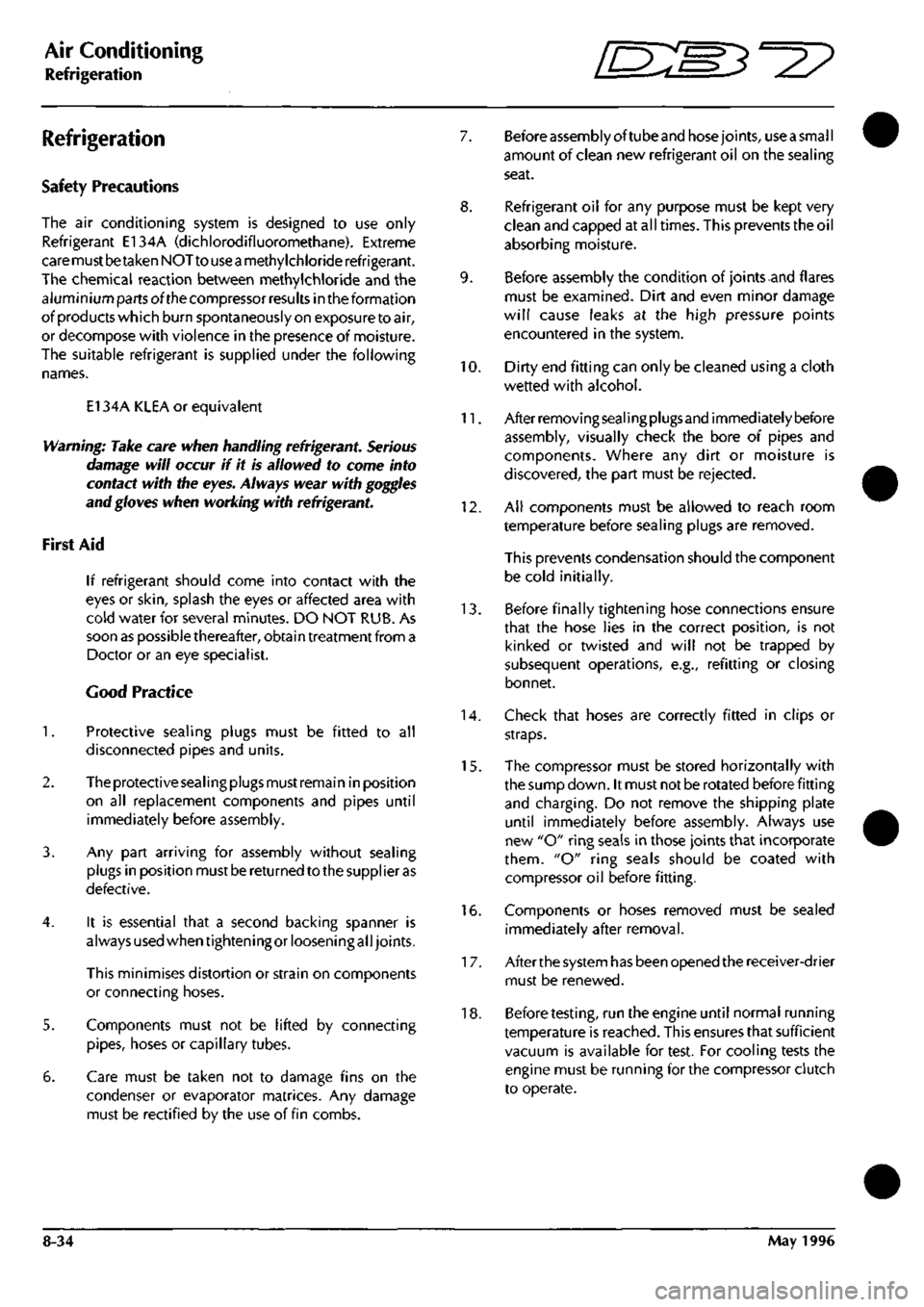
Air Conditioning
Refrigeration /s:s^°27
Refrigeration
Safety Precautions
The air conditioning system is designed to use only
Refrigerant E134A (dichlorodifluoromethane). Extreme
care must betaken NOT to use
a
methylchloride refrigerant.
The chemical reaction between methylchloride and the
aluminium parts ofthe compressor results in the formation
ofproductswhich burn spontaneously on exposure toair,
or decompose with violence in the presence of moisture.
The suitable refrigerant is supplied under the following
names.
El 34A KLEA or equivalent
Warning: Take care when handling refrigerant. Serious
damage will occur if it is allowed to come into
contact with the eyes. Always wear with goggles
and gloves when working with refrigerant
First Aid
If refrigerant should come into contact with the
eyes or
skin,
splash the eyes or affected area with
cold water for several minutes. DO NOT RUB. As
soon as possible thereafter, obtain treatment from a
Doctor or an eye specialist.
Good Practice
1.
Protective sealing plugs must be fitted to all
disconnected pipes and units.
2.
Theprotectivesealingpiugsmustremain inposition
on ail replacement components and pipes until
immediately before assembly.
3. Any part arriving for assembly without sealing
plugs in position must be returned to the supplier as
defective.
4.
It is essential that a second backing spanner is
always used when tightening or loosening all joints.
This minimises distortion or strain on components
or connecting hoses.
5. Components must not be lifted by connecting
pipes,
hoses or capillary tubes.
6. Care must be taken not to damage fins on the
condenser or evaporator matrices. Any damage
must be rectified by the use of fin combs.
7. Before assembly oftube and hosejoints, use
a
small
amount of clean new refrigerant oil on the sealing
seat.
8. Refrigerant oil for any purpose must be kept very
clean and capped at all times. This prevents the oil
absorbing moisture.
9. Before assembly the condition of joints and flares
must be examined. Dirt and even minor damage
will cause leaks at the high pressure points
encountered in the system.
10.
Dirty end fitting can only be cleaned using a cloth
wetted with alcohol.
11.
Afterremovingsealingplugsand immediatelybefore
assembly, visually check the bore of pipes and
components. Where any dirt or moisture is
discovered,
the part must be rejected.
12. Ail components must be allowed to reach room
temperature before sealing plugs are removed.
This prevents condensation should the component
be cold initially.
13.
Before finally tightening hose connections ensure
that the hose lies in the correct position, is not
kinked or twisted and will not be trapped by
subsequent operations, e.g., refitting or closing
bonnet.
14.
Check that hoses are correctly fitted in clips or
straps.
15.
The compressor must be stored horizontally with
the sump down. It must not be rotated before fitting
and charging. Do not remove the shipping plate
until immediately before assembly. Always use
new "O" ring seals in those joints that incorporate
them.
"O" ring seals should be coated with
compressor oil before fitting.
16.
Components or hoses removed must be sealed
immediately after removal.
1 7. Afterthe system has been opened the receiver-drier
must be renewed.
18.
Before
testing,
run the engine until normal running
temperature is reached. This ensures that sufficient
vacuum is available for test. For cooling tests the
engine must be running for the compressor clutch
to operate.
8-34 May 1996
Page 316 of 421
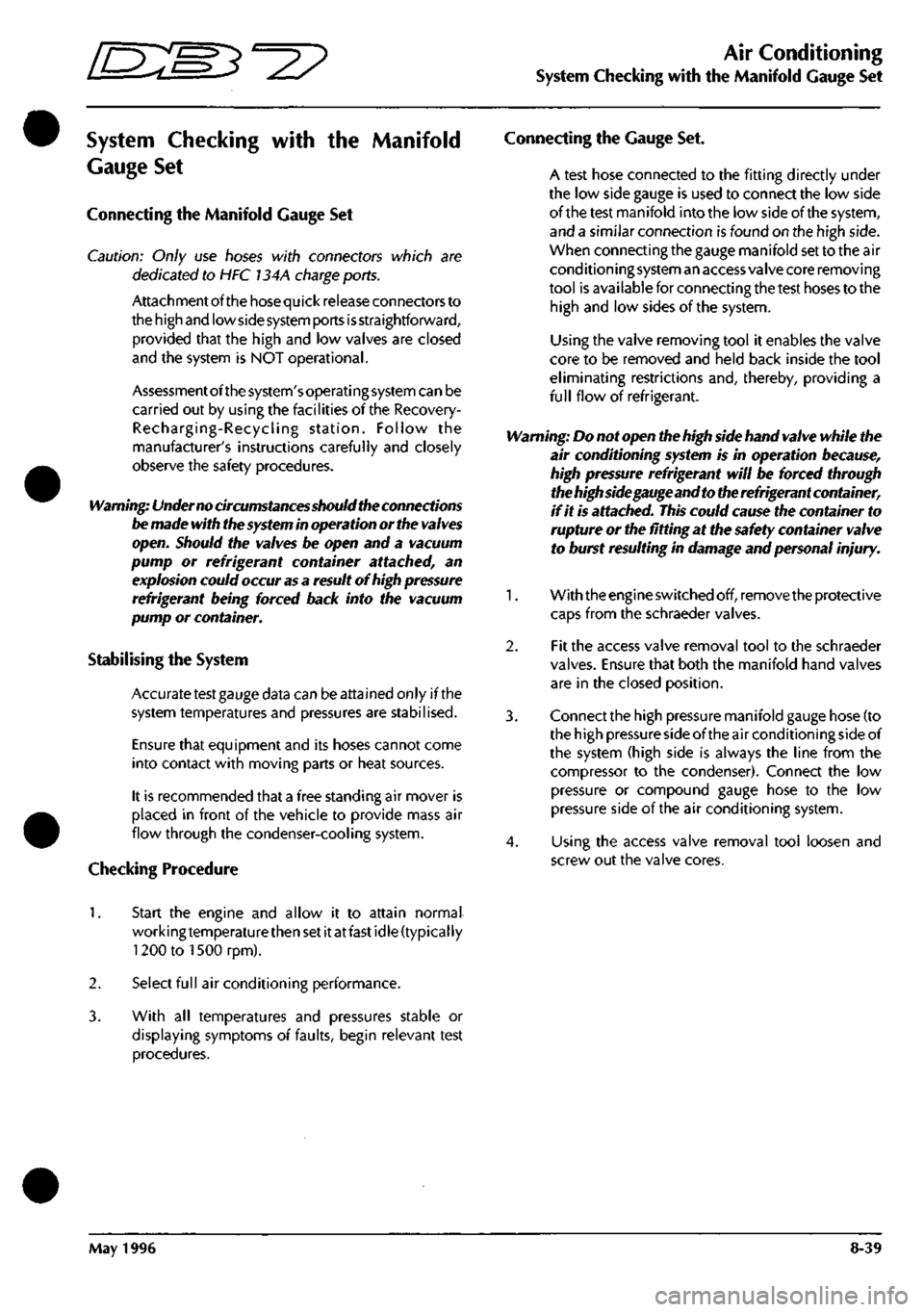
^=2?
Air Conditioning
System Checking with the Manifold Gauge Set
System Checking with the Manifold
Gauge Set
Connecting the Manifold Gauge Set
Caution: Only use hoses with connectors which are
dedicated to HFC 134A charge ports.
Attachmentofthehosequick release connectors to
the high and low side
system
ports
is
straightforward,
provided that the high and low valves are closed
and the system is NOT operational.
Assessment ofthe system's operating system can be
carried out by using the facilities ofthe Recovery-
Recharging-Recycling station. Follow the
manufacturer's instructions carefully and closely
observe the safety procedures.
Warning: Under no circumstances should the connections
be made with the
system
in operation or the
valves
open. Should the valves be open and a vacuum
pump or refrigerant container attached, an
explosion could occur
as
a result of high pressure
refrigerant being forced back into the vacuum
pump or container.
Stabilising the System
Accurate test gauge data can be attained only if the
system temperatures and pressures are stabilised.
Ensure that equipment and its hoses cannot come
into contact with moving parts or heat sources.
It is recommended that a free standing air mover is
placed in front of the vehicle to provide mass air
flow through the condenser-cooling system.
Checking Procedure
Connecting the Gauge Set.
A test hose connected to the fitting directly under
the low side gauge is used to connect the low side
ofthe test manifold into the low side ofthe system,
and a similar connection is found on the high side.
When connecting the gauge manifold set to the air
cond ition i ng system an access va Ive core removi ng
tool is available for connecting the test hoses to the
high and low sides ofthe system.
Using the valve removing tool it enables the valve
core to be removed and held back inside the tool
eliminating restrictions and, thereby, providing a
full flow of refrigerant.
Warning: Do not open the high side hand valve while the
air conditioning system is in operation because,
high pressure refrigerant will be forced through
the high side gauge and to the refrigerant container,
if it is attached.
This
could cause the container to
rupture or the fitting at the safety container valve
to burst resulting in damage and personal injury.
1.
With theengineswitched off, remove the protective
caps from the schraeder valves.
2.
Fit the access valve removal tool to the schraeder
valves. Ensure that both the manifold hand valves
are in the closed position.
3. Connect the high pressure manifold gauge hose (to
the high pressure side of the air conditioning side of
the system (high side is always the line from the
compressor to the condenser). Connect the low
pressure or compound gauge hose to the low
pressure side ofthe air conditioning system.
4.
Using the access valve removal tool loosen and
screw out the valve cores.
1.
Start the engine and allow it to attain normal
working temperature then set it at fast idle (typically
1200 to ISOOrpm).
2.
Select full air conditioning performance.
3. With all temperatures and pressures stable or
displaying symptoms of faults, begin relevant test
procedures.
May 1996 8-39
Page 324 of 421
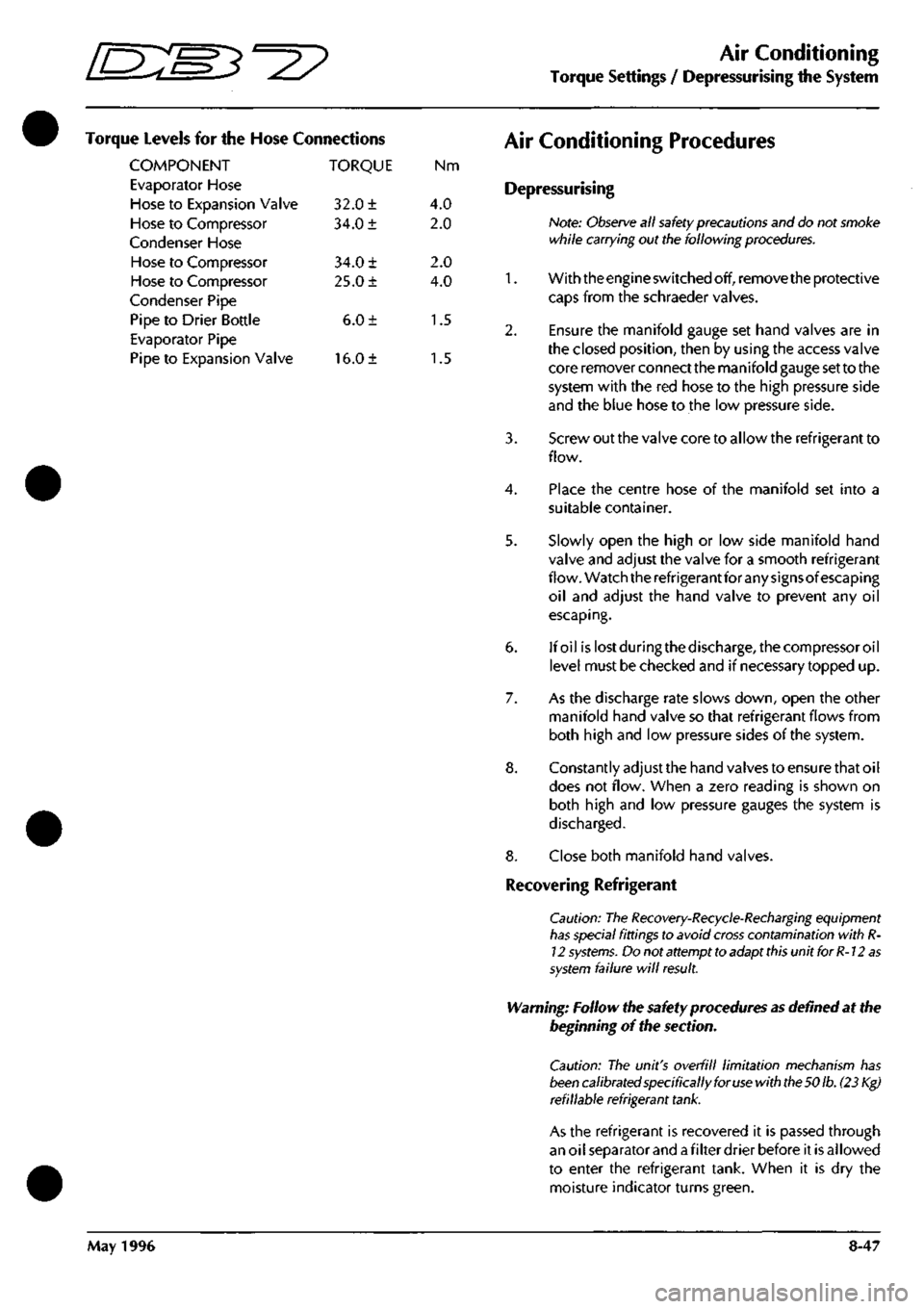
^?
Air Conditioning
Torque Settings / Depressurising the System
Torque Levels for the Hose Connections
COMPONENT TORQUE Nm
Evaporator Hose
Hose to Expansion Valve 32.0 ± 4.0
Hose to Compressor 34.0 ± 2.0
Condenser Hose
Hose to Compressor 34.0 ± 2.0
Hose to Compressor 25.0 ± 4.0
Condenser Pipe
Pipe to Drier Bottle 6.0 ± 1.5
Evaporator Pipe
Pipe to Expansion Valve 16.0 ± 1.5
Air Conditioning Procedures
Depressurising
Note:
Observe
all
safety
precautions and do not smoke
while carrying out the following
procedures.
1.
With the engine switched off, remove the protective
caps from the schraeder valves.
2.
Ensure the manifold gauge set hand valves are in
the closed position, then by using the access valve
core remover connect the manifold gauge set to the
system with the red hose to the high pressure side
and the blue hose to the low pressure side.
3. Screw out the valve core to allow the refrigerant to
flow.
4.
Place the centre hose of the manifold set into a
suitable container.
5. Slowly open the high or low side manifold hand
valve and adjust the valve for a smooth refrigerant
flow. Watch the refrigerant for any signsof escaping
oil and adjust the hand valve to prevent any oil
escaping.
6. If oil islostduringthedischarge,thecompressoroil
level must be checked and if necessary topped up.
7. As the discharge rate slows down, open the other
manifold hand valve so that refrigerant flows from
both high and low pressure sides of the system.
8. Constantly adjust the hand valves to ensure that oil
does not flow. When a zero reading is shown on
both high and low pressure gauges the system is
discharged.
8. Close both manifold hand valves.
Recovering Refrigerant
Caution: The
Recovery-Recycle-Recharging
equipment
has
special fittings to avoid
cross
contamination with
R-
12
systems.
Do not attempt to adapt
this
unit for
R-12
as
system
failure will
result.
Warning: Follow the safety procedures
as
defined at the
beginning of the section.
Caution: The unit's overfill limitation mechanism has
been
calibrated specifically for
use
with
the 50
lb.
(23 Kg)
refillable refrigerant
tank.
As the refrigerant is recovered it is passed through
an oil separator and
a
filter drier before it is allowed
to enter the refrigerant tank. When it is dry the
moisture indicator turns green.
May 1996 8-47